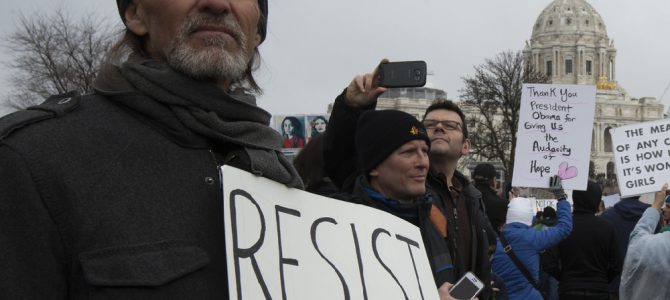
Democrats are desperately hoping that their self-described “Resistance” to President Trump can take off in the same way that opposition to President Obama launched a new political movement in 2009. As Molly Ball asks, “Is the Anti-Trump ‘Resistance’ the New Tea Party?”
No, it isn’t. They’ve been trying this ever since 2010, when some cloyingly earnest young lefties tried to start a Coffee Party that was launched with great fanfare and a lot of mainstream media publicity and never heard from again.
The Left never really tried to understand the Tea Party movement and what drove it, so they have no idea why it actually took off, and they are using vain hopes of a massive popular movement of their own to avoid confronting their real, underlying problems.
What people don’t realize about the Tea Party is the extent to which it was driven by much deeper structural political forces. Specifically, it was driven by a huge mismatch in congressional districts between constituents and their representatives. There were two factors behind this.
First, in 2006, the head of the Democratic Congressional Campaign Committee, Rahm Emanuel, recruited a bunch of conservative Democrats, particularly in the South, and used them to gain 28 seats in the House and win back a majority for the Democrats. They then promptly elected Nancy Pelosi as speaker of the House, who used these conservative Democrats as cannon fodder. They got elected in right-leaning districts in North Carolina and Pennsylvania and went off to Washington DC, where they were expected to rubber-stamp an agenda designed by a far-left leadership that came out of Boston (Barney Frank) and San Francisco (Pelosi).
Something had to give, and boy did it ever. By the time the 2014 congressional elections were over, the last white Southern Democrat—which is not quite the same thing as the last conservative Democrat, but it’s pretty close—had been kicked out of Congress.
The second factor behind the Tea Party is that Barack Obama had such a big surge of popularity in 2008 that he not only forestalled the reckoning for Pelosi’s conservative Democrats but got a bunch of solidly leftist Democrats elected in marginal districts. I saw this up close in Virginia’s Fifth Congressional District. It’s got a big left-leaning university town, Charlottesville, but also includes Jerry Falwell’s Liberty University down in Lynchburg and continues to a big swath of rural “Southside” Virginia. In that district, Tom Perriello—literally fresh off running a George Soros-funded NGO—got elected in 2008 by a margin of 800 votes. That just wasn’t going to last.
That was the context for the Tea Party movement. In a bunch of states and especially in a bunch of House districts, there was a fundamental imbalance between right-leaning constituents and left-leaning members of Congress.
The Tea Party was a big success insofar as it won two wave elections for the House GOP and kicked out a few Democratic senators. But this explains why it was less successful in the Senate: on average, the imbalance between senators and their constituents was less pronounced. That’s partly because of the staggered schedule of Senate elections, so that not every senator was swept in during the anomalous years of 2006 and 2008, and it’s partly because the larger and more diverse composition of states makes them less prone to wide ideological swings.
This also explains why the Tea Party fizzled out. It won enough elections to correct the basic political imbalance, and you’ll notice that the Trump phenomenon hasn’t yet marked a change of course in that respect. The GOP representatives elected in the Tea Party wave were re-elected, and with greater margins than Trump had. If you ask what happened to the Tea Party movement in Charlottesville, for example, the answer is: Robert Hurt beat Tom Perriello in 2010 and managed not to offend the Tea Party for three terms. (He decided not to run again in 2016, and VA-5 elected another Republican.) It took a lot of the political urgency out of the movement.
My own district, by the way, is VA-7, where we kicked out Eric Cantor. That’s another part of the Tea Party story, but a much smaller one. Kicking out incumbent Republicans who weren’t far enough to the right for their constituents did happen, but much less often, because most incumbent Republicans were not as complacent as Cantor.
The other big political wave of the Tea Party era was in the state houses, where we can see similar forces at work. It’s not just that the Democratic Party’s move to the left on the federal level has been a millstone around the necks of state-level Democrats. It that congressional Democrats have actively undermined conservative Democrats in state politics, forcing them to back policies like transgender bathroom laws and persecution of Christians who won’t bake the cake for a gay wedding.
In effect, the Democratic majorities of 2006 and 2008 were a false paradise, an inherently unstable arrangement just waiting for some trigger to set off a backlash—and ObamaCare, a big and intrusive new government program, provided that trigger.
For the Left to mount its own equivalent of the Tea Party movement, there would have to be an equivalent political imbalance behind it. I don’t see any such thing. To begin with, the Republicans who swept into Congress in the Tea Party waves of 2010 and 2014 are all still there and were recently re-elected. They weren’t supported by the coattails of a popular presidential candidate, because they won by much higher margins than Donald Trump did. So there’s little reason to believe they are mismatched to their constituents.
There is certainly a warning here to congressional Republicans not to be the conservative Democrats of 2006 and 2008. Don’t be Bart Stupak, the “pro-life” Democrat from Michigan who negotiated a compromise that allowed abortion funding in Obamacare—and was promptly shown the door by his constituents. Congressional Republicans shouldn’t allow President Trump to browbeat them into backing policies the folks back home will find unacceptable.
There may well be a public backlash against Trump this year, but for the most part, I think that’s already priced in. This is a guy who won with only 46 percent of the vote and three weeks into his administration has an RealClear-Politics average approval rating of 44 percent. He’s pre-backlashed. Barack Obama, by contrast, came into office with 70 percent approval. Trump’s negatives were known and very well advertised before Election Day. They are far less likely to come as a surprise to the average voter and therefore less likely to lead to a sudden reversal.
As I said, though, Democrats never really understood the Tea Party. In fact, they avoided understanding it because they preferred their own narrative to the facts. Most of them remain convinced, for example, that the Tea Party was not a real “grassroots” movement but was “astroturfed” with money from the Koch Brothers. I saw my local Tea Party on the ground level, and nothing could be further from the truth. Most of our local organizers were people who were not highly politically engaged before 2009, and there was nary a Koch dollar in sight, which is why everything was done with volunteer labor on a shoestring budget. It’s the closest thing I’ve ever experienced to the Norman Rockwell vision of old-fashioned town hall politics.
But if the Left still thinks the Tea Party was all just astroturfed, then they’re going to think that they can astroturf their own movement. That’s what strikes me about all this talk about “The Resistance.” It’s still early, but so far, a lot of this seems to be coming from people who were already activists, who were already highly politically engaged. It’s not spontaneous grassroots outrage. It’s the revolutionary vanguard trying to herd the proletariat into following them.
More fundamentally, in trying to make the revolution happen, they’re actually taking the political imbalance that produced the Tea Party movement (and, to some extent, the Trump campaign) and they’re making it worse. They are trying to build their own movement to serve a political agenda that is even more out of step with the voters they need to win back.
A very interesting election analysis at RealClearPolitics concluded that by moving farther to the left—farther toward the politics of Bernie Sander and Elizabeth Warren—Democrats have managed to build up their majorities in urban and coastal enclaves, at the expense of wiping themselves out everywhere else. “This hurts the Democrats’ chances in the Electoral College, and kills them in the House and Senate.” The only way to reverse this is the way Rahm Emanuel did it: revive the conservative Democrat.
But that’s the opposite of what the Resistance is trying to do, which is to make things like gay marriage and transgender bathrooms and abortion into even more intransigent litmus tests. The destruction of the conservative Democrat was not just some careless accident. For a lot of the activists on the Left, it was a deliberate goal.
Think of it this way. The most successful conservative Democrat in American politics right now is: Donald J. Trump—the very man the “Resistance” was formed to resist.
That’s why there won’t be a Tea Party movement for the Left. They’re not trying to take advantage of an ideological imbalance between members of Congress and their heartland districts. They’re trying to throw their own party even farther out of balance with the rest of the country.
Don’t worry, Republicans will still have many opportunities to sabotage themselves, and they have just the man in the Oval Office to help them do it. But that damage, if or when it comes, will be self-inflicted and have little to do with the current “Resistance.”
Follow Robert on Twitter.








